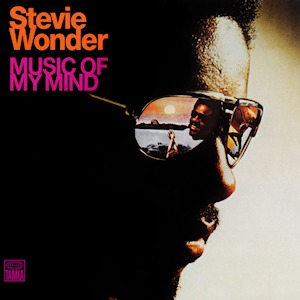Fact #79080
When:
Short story:
 Stevie Wonder releases his fourteenth album, Music Of My Mind, on Motown Records in the USA. It will be the first of five consecutive albums widely regarded as Wonder's 'classic period', the others being Talking Book, Innervisions, Fulfillingness' First Finale, and Songs in the Key of Life.
Stevie Wonder releases his fourteenth album, Music Of My Mind, on Motown Records in the USA. It will be the first of five consecutive albums widely regarded as Wonder's 'classic period', the others being Talking Book, Innervisions, Fulfillingness' First Finale, and Songs in the Key of Life.Full article:
Stevie Wonder: Well the two people who started with me in the beginning of all this, from when I did Music Of My Mind, were Bob Margouleff and Malcolm Cecil. And they were very innovative in their thinking... they had their own album out, [Tonto's Expanding Head Band] working with the Moog synthesizer and the Arp and all that kind of stuff. What they were really doing was making colours and creating pictures - sound pictures - if only for the fact they were working with a synthesizer at that time.
And being from England influenced Malcolm; the English had another way of thinking about engineering - image-eneering. You know, they would have the drums on one side and the voices on the other side, and their concept of stereo was just discrete channels of different things. Malcolm would say, "Well listen, let's have the drums, like, facing the drummer." And I said, "No, let's have it like I'm sitting at the drums..." and so it's like the listener is actually a part of it, like they're sitting behind the drums. We would go back and forth and talk about different ideas of creating pictures, song pictures, and that's really how it began.
Robert Margouleff (associate producer) : I had all the instruments set up in the studio in a circle - the piano, the clavinet, the Rhodes, the Moog, everything, Stevie could go, just like Braille, from one instrument to the next. They were all plugged in all the time. It was like a huge, instantaneous recording media. We fixed a lot of the instruments, modified our sound. We were using guitar boxes on the Rhodes, doing all kinds of experimental things.
(N.B. Jim Marron, manager of Electric Lady studios, speaks about this period in Stevie Wonder's career at http://www.radionz.co.nz/national/music/talk?result_551217_result_page=M)
Tweet this Fact
And being from England influenced Malcolm; the English had another way of thinking about engineering - image-eneering. You know, they would have the drums on one side and the voices on the other side, and their concept of stereo was just discrete channels of different things. Malcolm would say, "Well listen, let's have the drums, like, facing the drummer." And I said, "No, let's have it like I'm sitting at the drums..." and so it's like the listener is actually a part of it, like they're sitting behind the drums. We would go back and forth and talk about different ideas of creating pictures, song pictures, and that's really how it began.
Robert Margouleff (associate producer) : I had all the instruments set up in the studio in a circle - the piano, the clavinet, the Rhodes, the Moog, everything, Stevie could go, just like Braille, from one instrument to the next. They were all plugged in all the time. It was like a huge, instantaneous recording media. We fixed a lot of the instruments, modified our sound. We were using guitar boxes on the Rhodes, doing all kinds of experimental things.
(N.B. Jim Marron, manager of Electric Lady studios, speaks about this period in Stevie Wonder's career at http://www.radionz.co.nz/national/music/talk?result_551217_result_page=M)